This month is full of celebrations honoring our military. May 1 is Loyalty Day, which started in the 1920s to counter the rise of communism. [...] May 8 is V-E Day (Victory-in-Europe Day), which commemorates the end of fighting in Europe during World War II. Military Spouse Day is also on May 8 this year, … Continue reading Death of Honor
Tag: unemployment
What Happens When Unemployment Runs Dry?
[According to Forbes], short-term unemployment—six months or less—was 4.9% [in January 2013], [...] only 0.7% above the pre-recession rate. Long-term unemployment [...] is at 3%, which is three times higher than before the recession. The long-term unemployed make up 38% of all workers without jobs. This troubling [statistic] not only [affects] the societal safety net … Continue reading What Happens When Unemployment Runs Dry?
